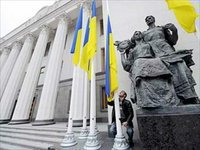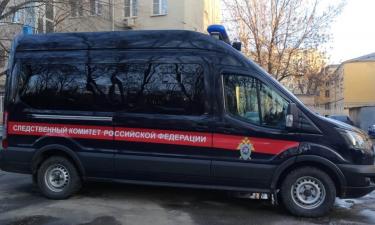The Untold History of Ukrainian Nationalist Movement and Jews
By Sam Craine

If you ask an American Jew their background, chances are they will respond "Russian Jew." That is not entirely correct. The majority of American Jewish families came over from the Ukraine. By the same token, the largest wave of immigration from Ukraine to the United States was Jewish. Yet, a trip to the Ukrainian museum in New York will leave you with the impression that there are, and never were, any Jews in Ukraine. Let's take a trip down memory lane, shall we?
In the time of the Czars, Ukraine was home to the second largest Jewish population center in Europe, after the Warsaw Ghetto in Poland, and followed by Belarus. The Holocaust changed all that. The Warsaw Ghetto was liquidated after an underdog Jewish last stand, bringing us to the Ukrainian nationalist movement.
During the war, the Ukrainian nationalists were Nazi collaborators. They collaborated in the Holocaust. In fact, the Ukrainians were the most enthusiastic Nazi collaborators in the Einsatzgruppe--the Nazi occupied western front, called the Pale Settlement.
The einsatzkommandos were tasked with, and responsible for, the first wave of ethnic cleansing, according to Hitler and Eichmann's "Final Solution" racialist genocide program targeting Jews. Of course, these were innocents and entire families who were murdered--often times in front of each other. Many were tortured, including Jewish children. Most were simply mowed down with machine guns during the first days of Nazi occupation. It was one of the largest mass murders in history. This was the main Nazi campaign that the Ukrainians participated in.
Nazis organized the so-called Galician Unit of the SS--the Nazi secret police force. Galicia was once a land bordering southwestern Ukraine. In Yiddish, the term Galician refers to Jews living in, or with roots in, the southern region of the Pale: Ukraine and Crimea, as well as Hungary and Romania. Many of these innocents were being protected by what the Jews call "righteous gentiles," non-Jews who risked their own lives to shelter Jews from Nazis. They would have survived the war, were it not for Ukrainian Nazis.
In Belarus, the second most Jewish country in the Pale Settlement, the opposite was true. A cable sent from the einsatzkommando leader to Hitler complains that "because of the passivity and political stupidity of the Belarussians it has been virtually impossible to stage pogroms against the Jews." Nazis had no such problem convincing the Ukrainians to volunteer. The Organization of Ukrainian Nationalists pledged their allegiance to Adolph Hitler.
The Ukrainians were not Nazis, according to the ideology of German supremacy. Hitler was pretty outspoken in describing the Ukrainians as an inferior race, for their Slavic blood. The Ukrainian Nazi alliance was only based on one thing: anti-Semitism.
Hitler's Minister of Propaganda Josef Goebbels infamously stated that "if you repeat a lie enough times, people will believe it." He produced and directed the psychological warfare of the Nazi Party. In the Nazi propaganda, Jewry was equated with Bolshevism. The Nazi propaganda that "98%" of the Bolshevik Party were Jews, was aimed at the occupied Ukrainians, with whom the message resonated. In actual fact, only one thousand Jews--out of five million in the Soviet Union--were members of the Bolsheviks, and the vast majority of those were assimilationists.
Stalin appointed Lazar Kaganovitch, Jew, as his head tax collector. That did not help to cure Ukrainian anti-Semitism. Still, it was easy for the Ukrainians to tell the difference between a single "court Jew" and the millions of regular Jewish villagers, and hard for them to not be able to tell the difference. They did not so much associate the Jews with Kaganovich, as they did associate Kaganovich with the Jews, in order to denounce them as a group.
To understand the racist phenomenon, one must look into the origins of the Ukrainian nationalist movement. The term "pogrom" loosely translated means anti-Jewish riot. This is a misnomer. Riots are popular uprisings that turn vandalistic. They are supposed to be spontaneous outbreaks of disorder, blamed on people getting swept up in the moment, and the madness of the crowd. The pogroms were coldly calculated in advance. Really, these were anti-Jewish raids. The marauders were for the most part Slavic militias. These same militias formed the Ukrainian nationalist armies. They fought against Russia, and blamed their Jewish neighbors for remaining loyal.
In 1648, Cossack Bogdan Chmelnitsky led the Cossacks and Ukrainian nationalists in an uprising against Poland. Along the way, they slaughtered tens of thousands of Jewish civilians. In 1918-1919, over twelve hundred pogroms took place in Ukraine. Over a third of those rampages were attributed to the Ukrainian nationalist army. In 1919, soldiers of the Ukrainian independent government, based in Kiev, massacred tens of thousands of Jewish innocents in the Ukraine. The pogromchiks rode into town on horseback, like the forces of Attila the Hun, on a destruction spree. The Jews formed self-defense units in order to fight back.
Anton Deniken was a leader of the Ukrainian nationalist movement. He was an anti-Semite. His army was called the Whites and they were fascists. Deniken's army targeted Jewish civilians with extreme brutality and savagery.
The other leading Ukrainian nationalist of the day was socialist Semyon Petlyura. He was an anti-Semite. Petlyura's forces rampaged through Jewish townships. The victims were not soldiers on the battlefield. These were working people and families, women, children, and the elderly, with little or no connection to politics. Petlyura considered the victims casualties of war. A Jew named Shalom Schwartzbard disagreed. He assassinated Petlyura to avenge his fallen family members, killed in Petlyura's pogroms.
When Nazis invaded Ukraine, they recruited Petlyurists. Three days after the nazi invasion of Ukraine, Ukrainian nationalists murdered six thousand Jewish POWs inside Brygidky prison in Lvov. Ukrainian nationalists declared a holiday called "Petlyura Day." It was celebrated by massacring over five thousand Jewish innocents. In 2009, the Germans traced down Ukrainian nationalist Ivan Demjanjuk. There was a want on him for war crimes and a debt to be paid. He was a commander in the Galician Unit and a guard at the Sobidor death camp. Demjanjuk was accused of personally suffocating Jewish prisoners to death, by pumping carbon monoxide into their showers, as well as murdering German civilians, and leading Ukrainian death squads. They found him in the United States, living under the name John Demjanjuk, in the heart of Cleveland's Ukrainian community, where he reportedly continued to remain active in nationalist circles. He was convicted of crimes against humanity.
Sam Craine
New York
Subscribe to Pravda.Ru Telegram channel, Facebook, RSS!





